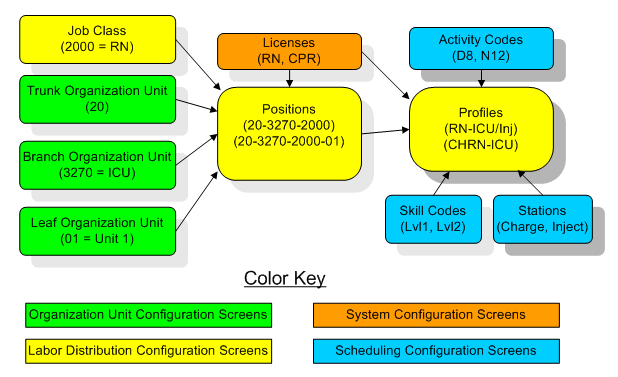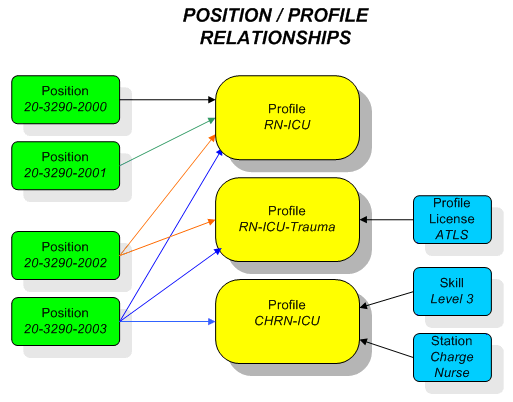 Position Codes identify a Job Class held by one or more employees within a specific
Position Codes identify a Job Class held by one or more employees within a specific  Organization Unit. Positions assigned to an employee determine if the employee is qualified to work a schedule opening.
Organization Unit. Positions assigned to an employee determine if the employee is qualified to work a schedule opening.Organization units are the corporate structure levels of a health care facility. There may be up to nine organization levels in a corporation, but only three are used directly for scheduling and time and attendance. These three main levels are generically called the Trunk, Branch, and Leaf levels. In the fields displayed in Time and Attendance and Staffing and Scheduling, the labels display the names of these levels that are specific to the corporation, which are defined with the initial setup of the system.
Each position identifies a job class held by one or more employees within a specific labor distribution. For example, positions are used to differentiate an RN who works in the ICU department from an RN who works in the Med-Surg department. Position codes can be created by stringing together (or concatenating) the organization unit codes and the job class code identifying the position. For example a trunk organization unit code (20) plus the branch organization unit code (3270) plus the job class code (2000) can be concatenated to create the position code of 20-3270-2000.
Employee positions are used to determine the schedules an employee is authorized to work, staffing and payroll assignment tables the employee qualifies for, education requirements of the employee, etc.
For more information, see the Configuration section>Labor Distribution card>Position screen.
Positions are assigned to employees in their Employee record>Labor Distribution screen. Note: Within the Labor Distribution screen the employee may instead be assigned a Job Class and Organization Unit, which also defines a position. However, a position code is required when using the staffing/scheduling application, since positions are linked to the profiles used for scheduling.
 Profiles further define the requirements for employees for a schedule opening. They include
Profiles further define the requirements for employees for a schedule opening. They include  Position codes and may also include extra qualifications, such as
Position codes and may also include extra qualifications, such as  Skills,
Skills,  Stations, and/or
Stations, and/or  Profile Licenses. The Profile screen can also be set up to limit the Activity Codes that can be used to schedule employees in that Profile.
Profile Licenses. The Profile screen can also be set up to limit the Activity Codes that can be used to schedule employees in that Profile.Profile licenses are licenses or certifications that are required to work a specific profile. These licenses may not be required by the Position linked to the profile. For example, a license or certification to operate a specific piece of equipment (e.g., EEG, MRI) by a Lab-Tech position.
Stations are specific qualifications needed to work a profile assignment. Stations are used to differentiate between employees with the same job class/position who are qualified for a work assignment from those who are not. Only employees with matching station records in their employee record are qualified to be scheduled.
An example of a station qualification could be the Charge station, assigned to the Charge Nurse profile to differentiate between RN employees who are qualified to work as a charge nurse from those who are not. Only RN employees with the station of Charge would be scheduled to work as a Charge Nurse.
Skills can be used to qualify employees for an assignment by their expertise in the Position and/or Station requirements of the Profile. Employees must meet or exceed the minimum Skill Level value to qualify. For example, an RN position may require a skill level of 3 or above to be scheduled in the Charge Nurse profile.
Each position identifies a job class held by one or more employees within a specific labor distribution. For example, positions are used to differentiate an RN who works in the ICU department from an RN who works in the Med-Surg department. Position codes can be created by stringing together (or concatenating) the organization unit codes and the job class code identifying the position. For example a trunk organization unit code (20) plus the branch organization unit code (3270) plus the job class code (2000) can be concatenated to create the position code of 20-3270-2000.
Employee positions are used to determine the schedules an employee is authorized to work, staffing and payroll assignment tables the employee qualifies for, education requirements of the employee, etc.
For more information, see the Configuration section>Labor Distribution card>Position screen.
A profile is a scheduling assignment for an employee. Built into the profile codes are the qualifying position codes, station requirements, skill levels, and license requirements to work a schedule assignment.
For more information, see the Configuration section>Labor Distribution card>Profile.
- Multiple positions may be qualified to work the same profile: In the example below, the ICU department has Positions of 20-3290-2000, 20-3290-2001, 20-3290-2002, 20-3290-2003, and they are all equally qualified to work the RN-ICU profile.
- The same position may qualify to work multiple profiles: In the example below, Positions 20-3290-2002 and 20-3290-2003 are also qualified to work the RN-ICU-Trauma profile (employees must also have the license of ALTS). Position 20-3290-2003 is also qualified to work the CHRN-ICU profile (employees must also have a Skill Level of 3 and a Station of Charge Nurse).
- Employees are assigned
 Skills and
Skills and  Stations in their Employee Record>Labor Distribution screen>Skill Codes field and Stations button for the related Profile record.
Stations in their Employee Record>Labor Distribution screen>Skill Codes field and Stations button for the related Profile record.Stations are specific qualifications needed to work a profile assignment. Stations are used to differentiate between employees with the same job class/position who are qualified for a work assignment from those who are not. Only employees with matching station records in their employee record are qualified to be scheduled.
An example of a station qualification could be the Charge station, assigned to the Charge Nurse profile to differentiate between RN employees who are qualified to work as a charge nurse from those who are not. Only RN employees with the station of Charge would be scheduled to work as a Charge Nurse.
Skills can be used to qualify employees for an assignment by their expertise in the Position and/or Station requirements of the Profile. Employees must meet or exceed the minimum Skill Level value to qualify. For example, an RN position may require a skill level of 3 or above to be scheduled in the Charge Nurse profile.

 Position Codes identify a Job Class held by one or more employees within a specific
Position Codes identify a Job Class held by one or more employees within a specific  Organization Unit. Positions assigned to an employee determine if the employee is qualified to work a schedule opening.
Organization Unit. Positions assigned to an employee determine if the employee is qualified to work a schedule opening. Profiles further define the requirements for employees for a schedule opening. They include
Profiles further define the requirements for employees for a schedule opening. They include  Position codes and may also include extra qualifications, such as
Position codes and may also include extra qualifications, such as  Skills,
Skills,  Stations, and/or
Stations, and/or  Profile Licenses. The Profile screen can also be set up to limit the Activity Codes that can be used to schedule employees in that Profile.
Profile Licenses. The Profile screen can also be set up to limit the Activity Codes that can be used to schedule employees in that Profile. Skills and
Skills and  Stations in their Employee Record>Labor Distribution screen>Skill Codes field and Stations button for the related Profile record.
Stations in their Employee Record>Labor Distribution screen>Skill Codes field and Stations button for the related Profile record. Licenses may be required by the Position and/or the Profile. Licenses are created in the Licenses configuration screen and are attached as requirements in the Position screen>License section and/or the Profile screen>Licenses section.
Licenses may be required by the Position and/or the Profile. Licenses are created in the Licenses configuration screen and are attached as requirements in the Position screen>License section and/or the Profile screen>Licenses section.